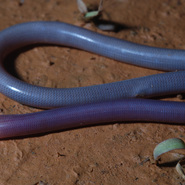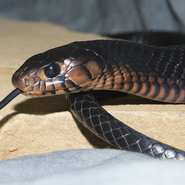Trimeresurus Insularis, also known as the white lipped island pit viper or lesser Sunda island pit viper, is an arboreal pit viper native to Indonesia. Individuals may be green, blue or yellow, with green being the most common. Regardless of body color, all individuals possess a red tail.
Cute snek. Would cuddle.
Gerrhopilus persephone, also known as the Normanby Island beaked blindsnake, is a scolecophidian snake that is native to Normanby Island in southeastern Papua New Guinea. Described in 2017, only a single specimen has ever been identified. Virtually nothing is known about it's ecology. The fact that it was climbing a tree when discovered has led some to suggest that it feeds on termites, which is typical prey for scolecophidians.
Drymarchon couperi, also known as the eastern indigo snake, is a colubrid snake native to the southeastern United States. They are present in nearly the entirety of Florida, which makes up most of their range. They also exist in parts of neighboring states including Georgia, Alabama, and Mississippi. Their generic name translates to "Lord of the forest", a fitting title as they are the largest native snakes in North America, reaching lengths of 8-9 feet (technically they are only the longest, the eastern diamondback rattlesnake (Crotalus adamanteus) is heavier). Although they hunt a wide variety of prey, they are best known for hunting venomous snakes, being immune to the venom of pit vipers. As a result, rattlesnakes react differently to eastern indigos than to other predators, keeping it's head low to the ground in an attempt to prevent the eastern indigo from grabbing hold of it while slowly retreating. This behavior can be seen here: https://www.youtube.com/watch?v=AD4Dkjm7pEM
Unlike many other non-venomous snakes, eastern indigos do not kill through kill constriction. Instead, they are known to either swallow prey alive or press it against objects. Eastern indigos display a considerable degree of intelligence, being capable of solving puzzles for food: https://www.youtube.com/watch?v=UroBQsFecSQ&t




